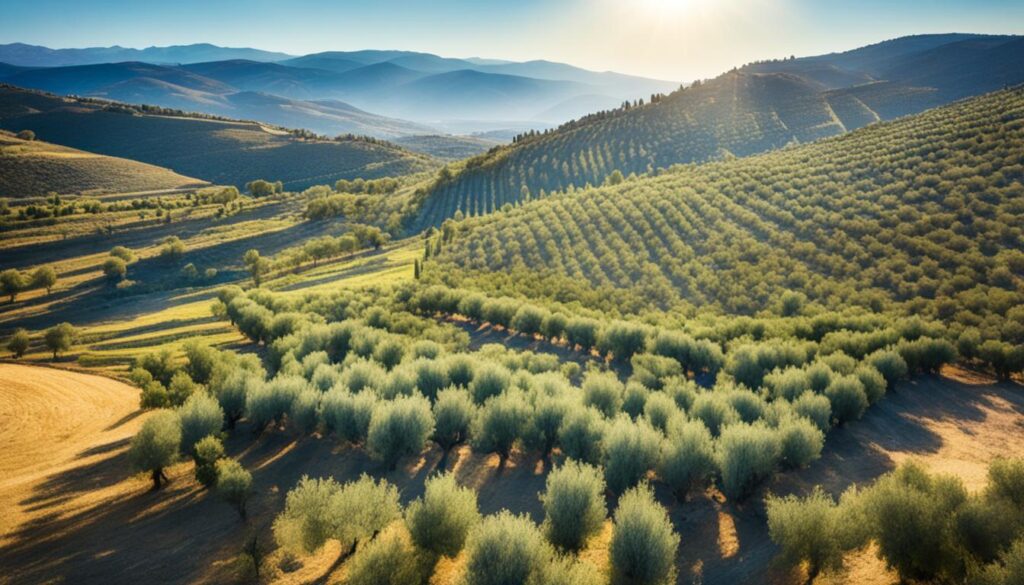Is Olive a Fruit or Vegetable? Unveil the Truth

Have you ever wondered about the classification of olives? Are they fruits or vegetables? In this article, we will explore the olive’s taxonomy and botanical classification to unravel this fascinating question. Let’s dive in and discover the true nature of olives.
- Understanding the olive’s classification
- Exploring the taxonomy and botanical attributes of olives
- Unveiling the true nature of olives
Understanding Olive Classification
To determine whether olives are fruits or vegetables, it is essential to comprehend their classification. By examining the different olive plant species and exploring their anatomy, we can shed light on their true classification.
Exploring Olive Plant Species
Olives come from various plant species that belong to the genus Olea in the family Oleaceae. The most common species include:
| Species | Common Name | Origin |
|---|---|---|
| Olea europaea | Mediterranean olive | Mediterranean region |
| Olea capensis | African olive | Africa |
| Olea cuspidata | Japanese olive | Japan |
| Olea europaea subsp. cuspidata | Wild olive | Asia and Africa |
These olive plant species have distinct characteristics and geographic origins, contributing to the rich diversity of olives.
Anatomy of Olives
Understanding the anatomy of olives can provide valuable insights into their classification. Olives consist of several parts, including:
- Exocarp: The outermost layer, also known as the skin, protects the olive.
- Mesocarp: The fleshy middle layer gives the olive its characteristic texture and flavor.
- Endocarp: The hard pit or stone encloses the seed within the olive.
- Seed: The reproductive part of the olive, responsible for the growth of a new olive tree.
The anatomy of the olive varies slightly between different olive cultivars, but these components are common to all olives.
Understanding the olive plant species and their anatomy is crucial in determining whether olives are fruits or vegetables. Let’s continue our exploration to unravel the true nature of olives.
Botanical Classification of Olives
In this section, we will delve into the fascinating botanical classification of olives, shedding light on their place within the plant kingdom and exploring their association with other plant groups.
When it comes to the food group to which olives belong, there is some debate. While they are commonly found in the fruit section of grocery stores, their classification as a fruit or vegetable is not as straightforward as it may seem.
Let’s take a closer look at the botanical aspects of olives and their relationship with other plant groups. The classification of olives is based on their taxonomic hierarchy, which is determined by their shared characteristics and evolutionary relationships.
Olives, scientifically known as Olea europaea, belong to the family Oleaceae. This family includes various flowering plants, such as jasmine and lilac. Within the family Oleaceae, olives belong to the genus Olea.
Now, let’s explore the groupings within the genus Olea. Olives are part of the species Olea europaea, which encompasses all the different cultivars and varieties of olives found around the world.
Interestingly, olives are further classified into different varieties based on factors such as their flavor profiles, size, and color. Some well-known olive varieties include the Kalamata, Manzanilla, and Black Mission olives.
While olives have a distinctive botanical classification, determining their food group affiliation is not as straightforward. In terms of nutrition, olives have a unique profile, combining flavors typically associated with both fruits and vegetables. They are known for their rich taste, high oil content, and numerous health benefits.
Here is a summary of the botanical classification of olives:
| Kingdom | Plantae |
|---|---|
| Phylum | Magnoliophyta |
| Class | Magnoliopsida |
| Order | Lamiales |
| Family | Oleaceae |
| Genus | Olea |
| Species | Olea europaea |
While the botanical classification of olives is crystal clear, their food group affiliation remains open to interpretation. Regardless, olives are undeniably a delightful addition to various dishes, adding a burst of flavor and a touch of Mediterranean charm.
The Olive Tree and Olive Farming
To gain a more comprehensive understanding of olives, we must explore the olive tree itself and the process of olive farming. The olive tree, scientifically known as Olea europaea, is native to the Mediterranean region and is widely cultivated for its fruit, the olive. Here are some key characteristics of the olive tree:
- Evergreen: The olive tree is an evergreen tree, retaining its leaves throughout the year. This makes it an aesthetically pleasing addition to landscapes.
- Drought-resistant: Olive trees are well-suited to arid climates and can thrive even in relatively dry conditions.
- Longevity: Olive trees have impressive lifespans and can live for hundreds of years, with some ancient specimens estimated to be over a thousand years old.
- Growth habit: The olive tree has a distinctive gnarled trunk and branches. It can reach heights of 20 to 40 feet, creating a striking presence.
Olive farming, also known as olive cultivation or olive growing, is the process of nurturing and harvesting olive trees for their fruit. This agricultural practice has been integral to Mediterranean cultures for thousands of years. Olive farming involves several essential steps:
- Planting: Olive trees are typically propagated from cuttings or young saplings. They require well-draining soil and adequate sunlight to thrive.
- Pruning: Regular pruning helps maintain the health and shape of the olive tree. It also promotes better fruit production and facilitates harvesting.
- Fruit development: Olive trees produce small, green fruits that gradually ripen to shades of purple or black. The time taken for the fruit to mature varies depending on the olive variety and growing conditions.
- Harvesting: Olives are harvested when they reach the desired level of ripeness. This can be done by handpicking or by using mechanical methods such as shaking the branches or using combs to collect the fruit.
- Processing: After harvesting, olives are processed to extract their oil or consumed as table olives. The processing methods vary depending on the desired end product.
Olive farming is not only a traditional practice but also a sustainable and environmentally friendly one. Olive trees contribute to soil conservation, prevent erosion, and provide habitats for various plant and animal species.

The cultivation of olive trees plays a crucial role in the production of olive oil, one of the most valued and versatile culinary ingredients worldwide. Additionally, olives themselves are enjoyed as a nutritious and flavorful addition to many dishes.
“Olive farming is a labor of love that allows us to connect with nature and preserve a rich cultural heritage.”
Now that we have explored the olive tree and the process of olive farming, the next sections will delve into the debate surrounding whether an olive is classified as a fruit or a vegetable. We will uncover the scientific truths behind this age-old question.
Is an Olive a Fruit?
Now, let’s dive into the debate: is an olive a fruit? To determine the answer, we will analyze the botanical definition of a fruit and carefully examine whether olives meet the criteria to be classified as such. By exploring their structure, development, and reproductive process, we will uncover the truth behind the classification of olives.
A fruit is the mature ovary of a flowering plant, typically containing seeds. It develops from the fertilized flower after pollination and plays a crucial role in seed dispersal.
In the case of olives, they indeed possess key characteristics that align with the botanical definition of a fruit. Let’s take a closer look:
1. Structure:
The structure of an olive consists of three main parts: the exocarp (outer skin), mesocarp (fleshy middle layer), and endocarp (hard inner pit). This layered structure is a defining feature of many fruits, including olives.
2. Development:
Olives undergo a developmental process similar to other fruits. After pollination, the flower’s ovary transforms into a small green olive, gradually ripening into different colors, such as purple, green, or black, depending on the variety. This color transformation is a clear indication of the fruit’s maturation.
3. Reproductive Process:
Olives are a product of pollination and contain seeds inside their pits. They rely on animals or other external factors to disperse these seeds and propagate new olive trees, just like many other fruits.
Considering these factors, it is evident that olives meet the criteria to be classified as fruits. While their savory taste may differentiate them from typical sweet fruits, their botanical attributes align with the category of fruits.
To further solidify this understanding, let’s take a look at a comprehensive table that compares the key characteristics of fruits and olives:
| Fruits | Olives |
|---|---|
| Develop from fertilized flowers | ✓ |
| Contain seeds | ✓ |
| Distinctive layered structure | ✓ |
| Undergo color transformation during maturation | ✓ |
| Rely on seed dispersal mechanisms | ✓ |
As you can see from the table, olives possess all the essential characteristics of fruits, reinforcing their classification within this botanical group.

Is an Olive a Vegetable?
While the debate over whether an olive is a fruit or a vegetable rages on, there are those who argue that olives should be classified as vegetables. In this section, we will explore the characteristics of vegetables and evaluate whether olives align with this classification. Through a thorough analysis, we aim to definitively resolve the question at hand.
Vegetables are typically defined as edible plant parts, such as leaves, stems, or roots, that are consumed as part of a savory meal. They are known for their nutritional value and are often rich in vitamins, minerals, and dietary fiber. Some common examples of vegetables include carrots, broccoli, and spinach.
When considering whether olives fit this definition, it’s important to examine their attributes. Olives are the small, oval-shaped fruits of the olive tree (Olea europaea). They have a distinct flavor profile, ranging from mild to sharply tangy, and are commonly used in various culinary applications.
Although olives are considered fruits botanically, some argue that their savory taste and frequent use in savory dishes should classify them as vegetables. Additionally, the preservation and processing methods used for olives, such as brining or marinating, contribute to their association with savory flavors.
To determine whether olives can truly be classified as vegetables, let’s compare them to traditional vegetables based on the key characteristics:
| Characteristic | Olives | Vegetables |
|---|---|---|
| Taste | Savory | Savory |
| Edible Plant Parts | Fruit (olive drupe) | Leaves, stems, roots, etc. |
| Nutritional Value | High in healthy fats | Rich in vitamins, minerals, and fiber |
As we can see from the comparison, olives do share some similarities with vegetables, such as their savory taste. However, olives are primarily classified as fruits due to their botanical characteristics, including their growth from flowers and their development from the ovary of the olive tree.
While the debate may continue, based on their botanical classification and distinct fruit characteristics, it is safe to conclude that olives are indeed fruits. Nevertheless, this classification does not diminish their versatility and importance in culinary creations. Olives can still be a flavorful addition to savory dishes and salads, enhancing their taste profiles and providing unique culinary experiences.
The Olive’s True Nature
After considering both perspectives on olive classification, it is now time to synthesize the information and uncover the true nature of olives. By bringing together various aspects such as olive taxonomy, their affiliation with a food group, and the characteristics of the olive tree, we can present a conclusive answer.
The Classification of Olives
In order to understand the true nature of olives, it is important to explore their classification. Olives belong to the Oleaceae family, which includes various species of flowering plants. The scientific name for the olive tree is Olea europaea.
Within the olive classification, there are several different cultivars or varieties of olives, each with its own unique characteristics. Some popular varieties include:
- Manzanillo
- Kalamata
- Picholine
- Arbequina
These cultivars may differ in terms of size, color, flavor, and oil content.
Olive Taxonomy
From a taxonomic perspective, olives fall under the following classifications:
| Taxonomy | Classification |
|---|---|
| Kingdom | Plantae |
| Order | Lamiales |
| Family | Oleaceae |
| Genus | Olea |
| Species | europaea |
As part of the Plantae kingdom, olives are clearly categorized as plants. This confirms that olives are not vegetables, as they do not belong to the vegetable food group.
Olive Tree and Olive Farming
The olive tree, known scientifically as Olea europaea, plays a crucial role in olive farming. It is an evergreen tree that can live for hundreds of years. The Mediterranean region, especially countries like Spain, Italy, and Greece, is known for its abundant olive tree groves.
To cultivate olives, farmers use various farming techniques, including pruning, irrigation, and pest control. The olives are harvested when they reach their optimal ripeness, typically in late summer or early autumn.
A Conclusive Answer
Bringing together the olive classification, taxonomy, affiliation with a food group, and the characteristics of the olive tree, we can now confidently conclude that olives are fruits. Despite their unique taste and texture, olives meet the botanical definition of fruits due to their reproductive process and structural composition.
Understanding the olive’s true nature as a fruit allows us to fully appreciate its versatility. Whether enjoyed as table olives, used in olive oil production, or incorporated into various culinary dishes, olives continue to captivate our taste buds and enhance our gastronomic experiences.
Conclusion
After a thorough exploration of olive classification and a deep dive into its taxonomy and botanical attributes, it is clear that olives are indeed fruits. While this may come as a surprise to some, scientific evidence unequivocally supports their classification as fruits. Understanding the true nature of olives can foster a greater appreciation for this versatile and delectable fruit.
Olive classification is based on scientific criteria rather than our conventional expectations. Although olives do not fit the typical fruit profile, their unique characteristics and reproductive process align with the botanical definition of fruits. They develop from the ovary of the olive flower and contain seeds, meeting the fundamental criteria of being a fruit.
By recognizing olives as fruits, we acknowledge the crucial role they play in horticulture, culinary arts, and our overall understanding of the diverse plant kingdom. Furthermore, understanding olive taxonomy can provide insights not only into their botanical classification, but also their relationships with other plant groups and their placement within the natural world.
In conclusion, with their classification as fruits firmly established through olive taxonomy and botanical analysis, let us savor the rich flavors and health benefits that olives offer. Whether enjoyed as a standalone snack, a flavorful addition to various dishes, or as a source of heart-healthy olive oil, olives exemplify the beauty and complexity of nature’s bountiful fruit kingdom.







